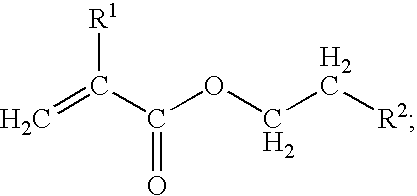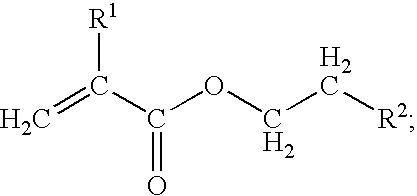[0030] The silicone-acrylate impact modifier compositions disclosed herein can be prepared by
emulsion polymerization techniques. In the first step of the technique, at least one
silicone rubber monomer is reacted with at least one first graft link monomer at a temperature from about 30.degree. C. to about 110.degree. C., and preferably from about 75.degree. C. to about 95.degree. C., to form a silicone rubber latex. An effective amount of a surfactant can be used initially in the reactor as part of the agitated aqueous mixture, or it can be introduced with the silicone rubber monomers. Surfactants that can be used include acid catalyst-surfactants, for example, sulfonic acids, such as
alkyl-, and alkaryl-
arylsulfonic acids and mixtures of surface-active
sulfonic acid salts with strong mineral acids.
Dodecylbenzenesulfonic acid is a preferred surfactant. In one embodiment of the method, the addition of monomers can be carried out batch wise or semi-continuously, and in a drop wise manner, over a period of up to 24 hours. The types of silicone rubber monomers and the first graft link monomers that can be used have been described previously. In another embodiment of the method, cyclooctamethyltetrasiloxane (hereinafter sometimes referred to as "D.sub.4") and tetraethoxyorthosilicate (sometimes also referred to as a silicone cross linking monomer) are reacted with (gamma-methaacryloxyprop-yl)methyldimethoxysilane (hereinafter sometimes referred to as "MAPMDMS") as a first graft link monomer to form silicone rubber particles. MAPDMMS facilitates chemical linking of acrylate chains onto the
siloxane network. TEOS serves to form a weak cross-link in the silicone rubber particles. The
average size of the silicone rubber particle depends on the cross-linking density. A higher cross-linking density generally results in a lowered particle size of the silicone rubber particles. In one embodiment, the method affords silicone rubber having an average particle size from about 100 nanometers to about 2 microns.
[0031] In the second step of the technique, at least one branched acrylate rubber monomer of the structure (I) is polymerized with the silicone rubber particles obtained in the first step to provide a latex comprising an
emulsion polymerized silicone-acrylate rubber
hybrid. In one embodiment, a branched acrylate rubber monomer of formula (I), such as
isooctyl acrylate is polymerized with the silicone rubber particles in presence of a cross linking monomer, such as allylmethacrylate to get silicone-acrylate
hybrid latex particles. Allylmethacrylate performs the
dual function of cross linking the acrylate chains as well as acting as a graft
linker (via the allyl group) for the
grafting reaction in the third stage as described later in the disclosure. In another embodiment, a mixture of acrylate rubber monomers comprising the branched acrylate rubber monomers of structure (I) and linear acrylate rubber monomers, such as
butyl acrylate can also be employed. The addition of the acrylate monomers to the silicone rubber latex occurs before, or concurrently with addition of a
polymerization catalyst. The polymerization catalyst can be any material known in the art to initiate free
radical polymerization, such as an
alkali metal persulfate; or organic soluble radical initiators, such as
azobisisobutyronitrile, or an
organic peroxide, such as
benzoyl peroxide, dichlorobenzoyl
peroxide cumene hydroperoxide, and tert-butyl perbenzoate, to polymerize the branched acrylate rubber monomer and effect silicone-acrylate rubber hybrid formation. When an
alkali metal persulfate catalyst is used, it is preferred that the
persulfate be added over time to keep the vinyl polymerization running. This technique also minimizes degradation of the persulfate under the acid conditions present during the polymerization of the silicone rubber monomers. The emulsion polymerized silicone-acrylate rubber hybrid comprises about 95 parts to about 5 parts by weight of silicone rubber, and about 5 parts to about 95 parts by weight of polyacrylate rubber, per 100 parts by weight of said silicone acrylate rubber hybrid.
[0036] The silicone-acrylate impact modifier compositions disclosed hereinabove are useful materials for preparing
polymer molding compositions having improved properties, such as stiffness, low temperature
ductility, weatherability, and
chemical resistance. The impact modifier compositions also confer unexpectedly, a higher melt
volume rate to
polymer and molding compositions during the
processing step. A higher melt
volume rate generally translates to easier
processing of the
polymer or molding compositions, which can be a significant benefit commercially.
[0043] The molding compositions comprising different polymer resins and the silicone-acrylate impact modifier compositions disclosed herein posses superior properties, such as low temperature impact and ductility, as compared to the
polymer resin compositions which comprises
methyl methacrylate-butadiene-
styrene block
copolymer impact modifier.
[0044] The previously described embodiments of the present invention have many advantages, including the ability to prepare the silicone-acrylate impact modifier compositions, and new molding compositions having superior low temperature impact, ductility, and good weatherability.
 Login to View More
Login to View More 


